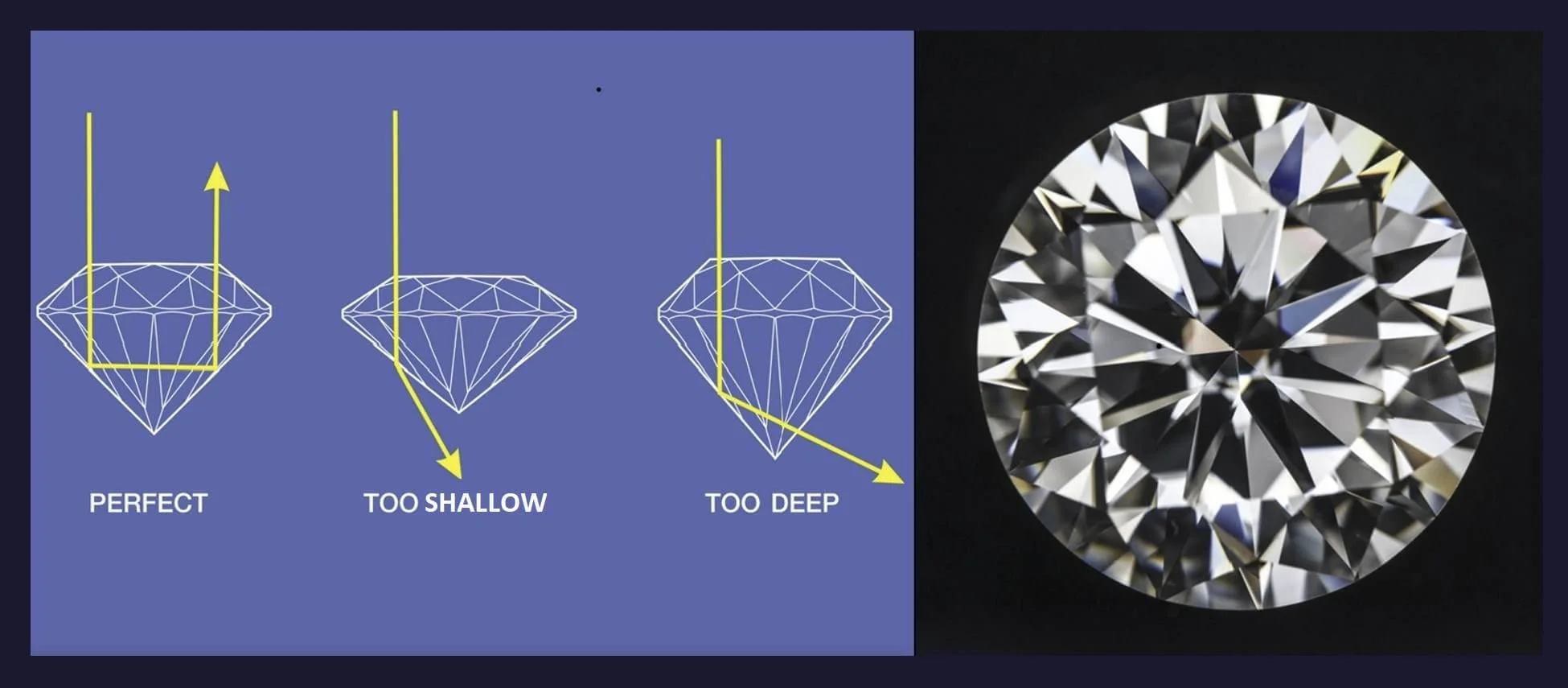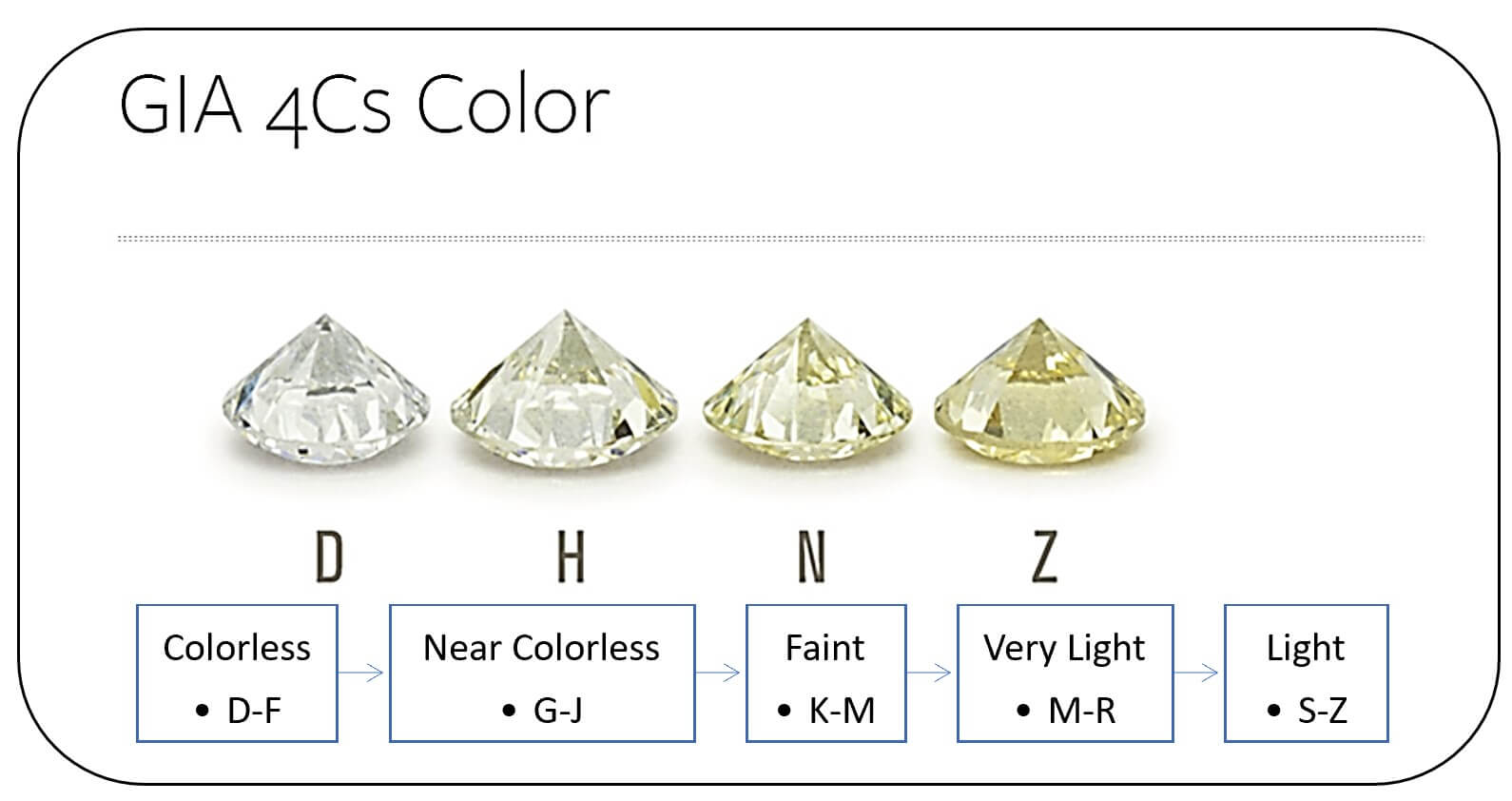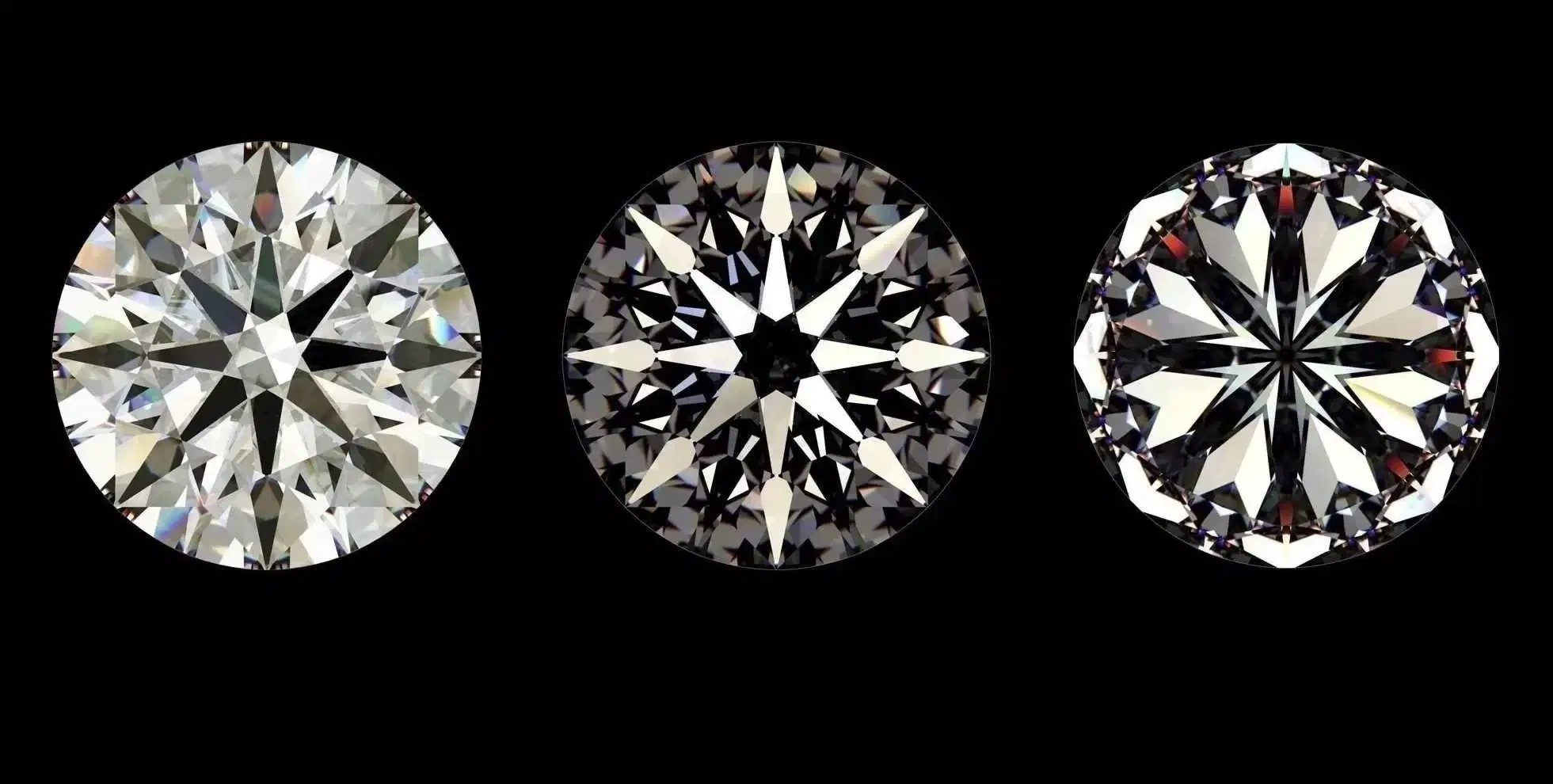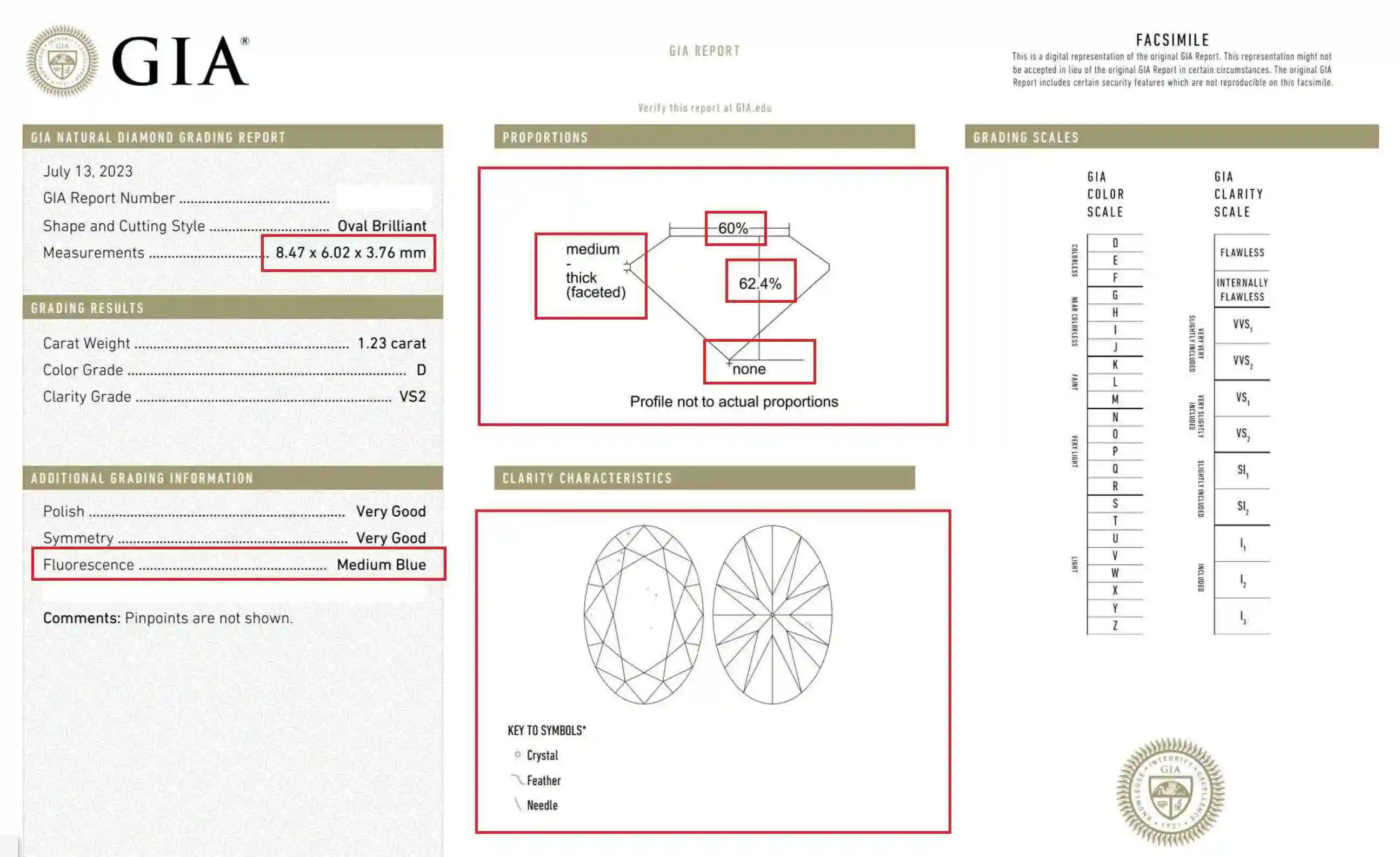A diamond's shape,
weight, Cut, clarity, color, certification, and fluorescence are all crucial
factors to consider when buying a diamond. As such, we have provided a summary of key insights buyers should consider under these critical factors.
Factor 1: Diamond Shape

|
The "shape" is how the
diamond looks, and the "cut" refers to the quality of the craftsmanship while cutting
a diamond into a particular shape, e.g., a round cut or an
oval cut. A diamond's shape impacts its price because certain shapes might require larger unpolished stones. For example, a round shaped diamond is 20-30% more
expensive than a princess cut or cushion cut diamond.
It could take a
2 carat rough diamond to cut a perfect 1 carat round brilliant cut, while it
might take a 1.5 carat rough diamond to cut a princess cut diamond [a round
1 carat diamond is usually 6.5mm in diameter, and a 1 carat princess cut is roughly 5.5mm]. As a result of the size difference, round cut diamonds are priced
higher than other shapes.
|
Factor 2: Diamond Carat Weight
After determining the
shape of a diamond, the next step is to learn about the carat weight of a
diamond. Typically, a diamond is weighed in carats, and each carat is 200
milligrams or 0.2 grams. The price of a diamond increases significantly as it
reaches a full carat. Once a diamond reaches the 2 or carat range, the price is multiplied by many times because larger stones are rare and, therefore, more expensive. For instance, if all other factors are considered equal, a 2 carat diamond will cost three to four times the price of a 1 carat diamond. This is
because a 2 carat diamond is more scarce or rare to mine than a 1 carat diamond.
Tip: If you want to save money, buying a
1.9 carat diamond may be less expensive than a full 2 carat diamond. The price
jumps significantly once the diamond reaches a full carat range.
Factor 3: Diamond Cut

The cut of a diamond is essential
because it is the only C determined by a cutter and not nature. The cut of a diamond is complex, and several factors must be considered while
evaluating a diamond's cut quality. GIA only assigns a cut grade to round diamonds and does
not yet have a standard grading system for fancy cut stones such as a princess cut.
The good news is that
we have published detailed articles about each shape and how to assess its cut. For
example, check our guide on oval cut diamonds.
Tip 1: Even among GIA excellent cut round
diamonds, there is a way to differentiate between an excellent cut diamond and
what we refer to as an "ideal supercut" diamond. The best way to
distinguish between them is by thoroughly analyzing the cut proportions of
the diamond (read our article on ideal cut proportions).
Tip 2: In both round and fancy cut diamonds,
the depth and table are the most important factors in determining the quality
of the cut, followed by the size of the girdle, culet, crown angle, and
pavilion. Length-to-width ratios are also important in fancy shape stones.
Tip 3: Dealers tend to cut a diamond deep to save
the original rough stone. It is best to avoid a diamond with a large depth. A large table is also not recommended because it will lack optimal fire
and brilliance.
Factor 4: Diamond Color

Color in diamonds is
the second most important C after the cut of a diamond, as the whole body of a
stone is affected by it, not a particular spot, as is often the case with clarity.
Color refers to a yellowish hue or tint in a white diamond and is graded from grade
D (colorless) to grade Z (light yellow). D to F color grades are considered colorless,
G to J are near colorless (however, there is a big difference between G and J
color), K to M grades are faint yellow, N to R are very light yellow,
and S to Z grades are light yellow.
Tip: We recommend D, E, F, and G as excellent
color ranges. H and I diamonds are also excellent budget options. J is our
lowest recommendation unless some yellowish tint is preferred in a diamond.
Factor 5: Diamond Clarity

The clarity of a diamond is
important because it directly affects its brilliance. If a diamond is full of
inclusions, the stone will not sparkle and will lack luster, fire, and
scintillation.
The diamond industry
has developed a sophisticated system for grading a diamond's clarity, with Flawless (FL) being the highest grade and Included 3 (I3) being the
lowest grade.
FL and IF (Internally
Flawless) are excellent grades. Very Very Slightly Included 1 (VVS1) and Very
Slightly Included 2 (VVS2) are almost flawless clarity grades. VS1 and VS2 are
after VVS2 and are often considered eye-clean diamonds.
Slightly Included 1 (SI1) and Slightly Included 2 (SI2) are at the lower end
of high-quality diamonds and are close to being eye-clean in diamonds under 1 carat. Included 1 (I1) and Included 3 (I3) are the lowest clarity grades.
Tip: FL, IF, and VVS/VS1 are
excellent premium grade diamonds. VS2 is a good option to consider while
prioritizing quality and budget. SI1 and SI2 need extensive due diligence in the above 1 carat diamonds to avoid inclusions that might affect a diamond's brilliance.
Factor 6: Diamond Fluorescence
Fluorescence is
an invisible glow that a diamond emits when exposed to ultraviolet rays. It ranges from None to Very Strong Blue, with Faint, Medium, and Strong Blue being the other ranges.
According to a GIA
study, the appearance of around 10% of diamonds was negatively affected among
all diamonds that emitted fluorescence. Fluorescence can negatively influence
the price of a diamond by up to 25%.
In summary, fluorescence can be a helpful factor for buyers on a
tight budget. It can make H or lower color grade diamonds look whiter because
fluorescence is often blue, a complementary color to yellow.
Tip: Fluorescence can be a plus in H
and lower color grade diamonds. However, no fluorescence is always much better
in higher color grades such as D to G. If you go with fluorescence in D to G
colors, make sure you have a valid return policy in case the diamond is among the
10% of stones badly affected by fluorescence.
Factor 7: Diamond Certification
While it is commonly
referred to as "diamond certification,"
within the diamond industry, we refer to the "certificates" as
grading reports. Among the many labs that offer grading services, the best lab
is GIA (the Gemological Institute of America), a non-profit organization
dedicated to educating customers about diamonds and other gemstones.
Tip: We strongly
encourage shoppers to buy a diamond with a GIA grading report to avoid getting riffed off. If a
dealer offers a good deal on a stone graded by a bogus lab or not graded at
all, there is a strong reason to be concerned.






